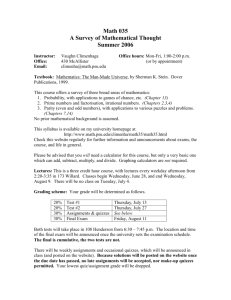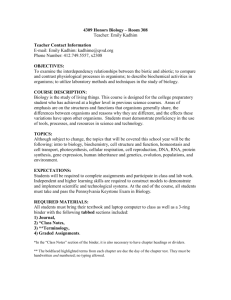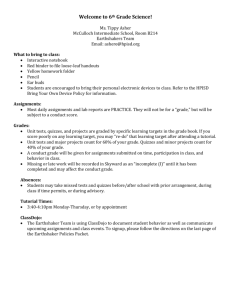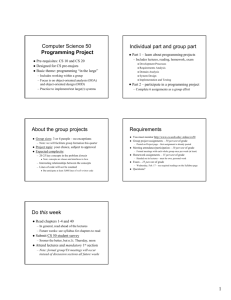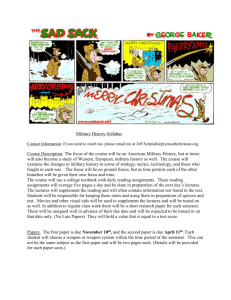Life Science I 83.101.102 Dr. Ekaterina (Kate) Vorotnikova Office
advertisement
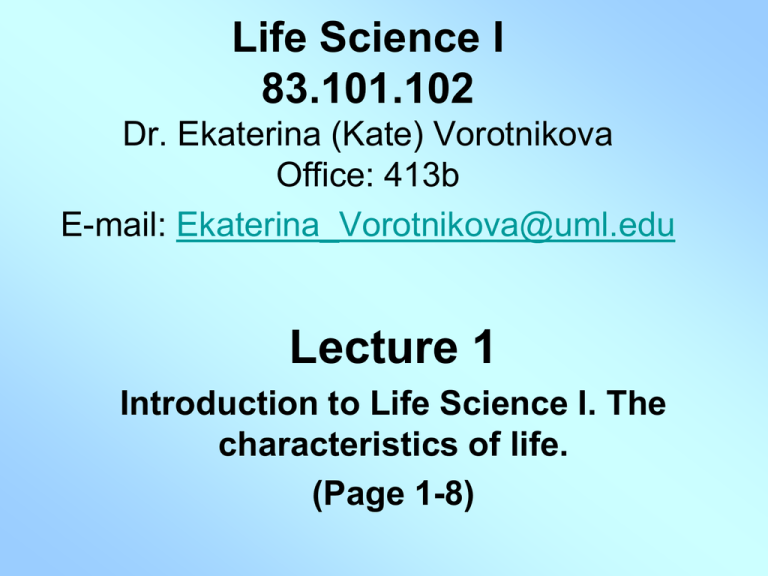
Life Science I 83.101.102 Dr. Ekaterina (Kate) Vorotnikova Office: 413b E-mail: Ekaterina_Vorotnikova@uml.edu Lecture 1 Introduction to Life Science I. The characteristics of life. (Page 1-8) Wednesday, Feb.3, 9:00 a.m.9:50 a.m. Dr. Mark Hines, Professor and Biological Sciences Department Chair will give a lecture on Climate changes Life Science I Presents environmental and organismal structural interrelationships and relates these to the chemical evolutionary basis of life. Essentials of Biology Second Edition Sylvia S. Mader with McGraw-Hill Connect Biology McGraw-Hill Connect Biology: • is a web-based assignment and assessment platform that gives students the means to better connect with their coursework, with their instructors; •with Connect Biology, instructors can deliver assignments, quizzes and tests easily online; • students can practice important skills at their own pace and on their own schedule. • with Connect Biology Plus, students also get online access to an eBook—an online edition of the text—to aid them in successfully completing their work, wherever and whenever they choose. Attendance • Attendance is required at all lectures. • Students who attend lectures regularly will receive extra 5 points to their final grade. • The lecture slides in ppt will be placed on the web site. Also, you will be able to see your examination grades there • To see your grades and lectures you should register Registration to see exam grades and lectures Go to http://evorotnikova.pageout.net You will see Course Web Site Click on Life Science I 83.101.201 Go to Student Registration and follow the instructions to register Add your First Name Last Name User ID – any ID you like and DO NOT FORGET! User password – any password you like and DO NOT FORGET! After you register when you go to http://evorotnikova.pageout.net, then click on Life Science I 83.101.201, then click on Web Links – you will see the Lectures and syllabus in ppt. If you click on GradeBook – you will see your grades. DO NOT FORGET TO REGISTER!!!! EXAMS 1. February 17 - 100 points 2. March 12 - 100 points 3. April 14 - 100 points 4. Final May 13-18 – to be announced, 100 points Missed exams are counted as zero. Assignments •After each lecture students have an assignment that they should do at their convenient time. • On Monday and Wednesday an assignment will include 5-10 questions on a particular lecture material. • Each Friday there will be an assignment on a Friday lecture + a quiz on the material that includes 3 lectures of the week. • Assignments and a quiz for a particular week are due at 11 p.m. on Monday of the following week. •Assignments will be posted on the Connect McGraw-Hill website for which you should register. Quizzes Each Friday a quiz on the material that includes 3 lectures of the week together with a Friday lecture assignment will be posted on the Connect McGraw-Hill website. The quiz will have 10 questions, 10 points each. Quizzes and assignments will be done online Student registration info Course: Life Science 83.101.102 Instructor: Ekaterina Vorotnikova Section: Spring 2010 mwf 9 am online registration instructions Go to the following Web address and click the "register now" button: http://connect.mcgraw-hill.com/class/e_vorotnikova_spring_2010_mwf_9_am (http://connect.mcgraw-hill.com/class/e_vorotnikova_spring_2010_mwf_9_am) Web addresses cannot contain spaces. Use lowercase letters or numbers or special characters ( '-' and '_' ) only. This is a unique address for Spring 2010 mwf 9 am If you have trouble with registration, please contact Customer Support at http://mpss.mhhe.com LearnSmart Study modules Final grade Grade for exams – 50%; Grade for assignments – 20%; Grade for LearnSmart – 10% Grade for quizzes – 20%; (100 points max + 5 points for attendance.) Total number of points -105. Grade A AB+ B BC+ C CD+ D F Points 90 -- 100 87 -- 89 83 -- 86 80 -- 82 77 -- 79 73 -- 76 70 -- 72 65 -- 69 58 -- 64 50 -- 57 0 -- 49 Defining Life Living things: – Comprised of the same chemical elements e.g. Carbon, Hydrogen, Oxygen, and Nitrogen (96.3% of human body weight) – Obey the same physical and chemical laws – Living organisms consist of cells (Unicellular or Multicellular). • The cell is the basic structural and functional unit of all living things e.g. plants, animals, and fungi • Cells are produced from preexisting cells • Cells are the smallest units that perform all vital physiological functions 6,600 Escherichia coli 65,000 Cells are the structural and functional units of life Nerve cell (neuron) Fibroblasts Red blood cells and white blood cell Living things Are organized: there are different levels of biological organization. Acquire materials and energy: they process food to maintain their metabolism. Respond to stimuli: they interact with their surrounding. Reproduce and develop: make another organism like itself. Adapt to change: they modify to be better suited to environment LEVELS OF BIOLOGICAL ORGANIZATION • Each level of organization has Emergent Properties • Levels range from extreme micro (e.g. Atoms, Molecules and Cells) to global (e.g. Community, Ecosystem and Biosphere) • Each level of organization is more complex than the level preceding it All organisms need nutrients and energy Energy – required to maintaining organization and conducting life-sustaining processes The sun: Ultimate source of energy for nearly all life on Earth Living things acquire nutrients. Metabolism is all the chemical reactions that occur in a cell or in an organism. Homeostasis - Maintenance of internal conditions within certain boundaries LIVING THINGS RESPOND TO STIMULI Living things interact with the environment and respond to changes in the environment Response ensures survival of the organism and it often results movement Vulture can detect and find carcass a mile away and soar toward dinner Monarch butterfly senses approach of fall and migrates south Microroganisms can sense light or chemicals Even leaves of plants follow sun Activities as a result of Responses are termed behavior LIVING THINGS REPRODUCE AND DEVELOP Organisms live and die All living organisms must reproduce to ensure continued existence and maintain population In most multicellular organisms reproduction: Begins with union of sperm and egg (fertilization) Followed by cell division and differentiation Developmental instructions encoded in genes Composed of DNA Unicellular organisms reproduce by cell division LIVING THINGS ADAPT TO CHANGE Adaptation Any modification that makes an organism more suited to its way of life Organisms become modified over long period time Respond to environmental changes by developing new adaptations However, organisms very similar at basic level Suggests living things descended from same ancestor Descent with modification Evolution Caused by natural selection
